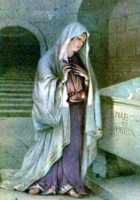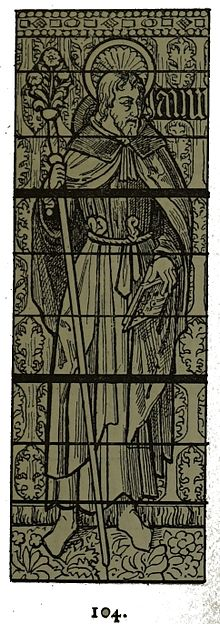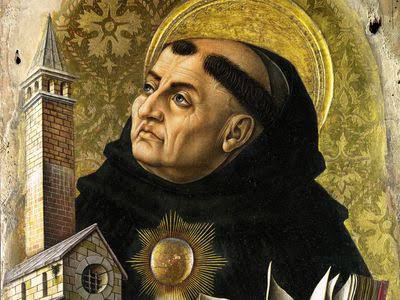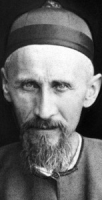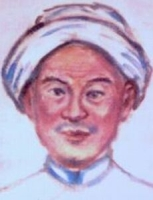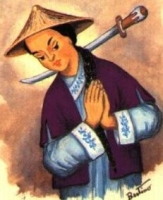Blessed Columba Marmion
Also known as
• Joseph Marmion
• Joseph Aloysius Marmion
Profile
Son of an Irish father, William Marmion, and French mother, Herminie Cordier. He entered the seminary in Dublin, Ireland in 1874, and studied at the College for the Propagation of the Faith in Rome, Italy from 1876. Ordained in Rome on 16 June 1881.
He dreamed of becoming a missionary monk in Australia, but spent several years as a parish priest in Dublin. Curate in Dundrum, and professor at the seminary at Clonliffe from 1882 to 1886. Chaplain and spiritual director of a Redemptorist convent and a women's prison.
In 1886 he renounced his promising ecclesiastical career, and entered the Benedictine Abbey of Maredsous in Belgium, taking the name Columba. Nearly 30 at the time of his noviate, and forced to learn a new language at the same time, he persevered and made his solemn profession on 10 February 1891.
Helped found the abbey of Mont César at Leuven, Belgium; served as its prior, spiritual director, and professor of theology and philosophy to younger monks. Began preaching retreats in Belgium and Britain. Spiritual director to communities of Carmelite nuns. Researcher and editor of several publications, including Revue Bénédictine. Elected abbot of Maradsous on 28 September 1909, a position he held the rest of his life.
During his time as abbot, Maredsous, famous for its beer and cheese, became a focal point for spiritual thinking in Europe. Worked for the union of Anglican Benedictine houses with Rome, and helped a house of Anglican monks who converted to Catholicism. Counselor to Queen Elisabeth of Belgium.
While the walls stood, World War I effectively destroyed his abbey. German lay-brothers, who had been there for years, were expelled from Belgium. Columba sent young monks to study in Ireland; they would be safer there, but the remaining brothers, including Columba, had to shoulder more work. After the war, a group of the brothers were sent to the Monastery of the Dormitian in Jerusalem, which had been left nearly deserted when the British expelled German monks. Amidst it all, Columba continued to preach retreats, guide the lost, and write.
The investigation for his Cause began on 7 February 1957, and the healing of a Minnesota woman in 1966 was performed through his intercession.
Born
1 April (Holy Thursday) 1858 at 57 Queen Street, Dublin, Ireland as Joseph Aloysius Marmion
Died
30 January 1923 at Maredsous Abbey, Denée, Namur, Belgium of influenza
Beatified
3 September 2000 by Pope John Paul II at Saint Peter's Basilica, Rome, Italy
Works
• Christ in His Mysteries (1919)
• Christ the Ideal of the Monk (1922)
• Christ the Life of the Soul (1917)
• Growth in Christ
• The Virgin Consecrated to Christ
• The Mysteries of the Rosary
• Joyful and Glorious Mysteries
• The Structure of God's Plan
Saint Bathilde
தூய பத்தில்திஸ் (St.Bathild )
நினைவுத் திருநாள் : ஜனவரி 30
மானிட மகன் தொண்டு ஏற்பதற்கு அல்ல, தொண்டு ஆற்றுவதற்கும் பலருடைய மீட்புக்கு ஈடாகத் தம் உயிரைக் கொடுப்பதற்கும் வந்தார் இயேசு.
வாழ்க்கை வரலாறு
பத்தில்திஸ், 635 ஆம் ஆண்டு இங்கிலாந்தில் பிறந்தார். இவர் வாழ்ந்த பகுதியில் கொள்ளையர் கூட்டத்தினுடைய ஆதிக்கம் அதிகமாக இருந்தது. ஒரு சமயம் டென்மார்க்கிலிருந்து வந்த கொள்ளையர்கள் பத்தில்திசையும் அவரோடு சேர்த்து ஒருசிலரையும் கடத்திச் சென்று, பிரான்சு நாட்டில் இருந்த அடிமைச் சந்தையில் விற்பனை செய்தது. பத்தில்திஸ் அடிமைச் சந்தையில் ஏலத்திற்கு விற்கப்பட்டுக்கொண்டிருந்த தருணத்தில், பிரான்சு நாட்டு அரசர் கிளோவியசின் அரசபையில் முக்கியப் பொறுப்பில் இருந்த எர்சினோல்டு அங்கு வந்தார். அவர் பத்தில்திசின் அழகில் மயங்கி, அவரை விலைக்கு வாங்கிக்கொண்டு வந்து, அரண்மனையில் பணிக்கு அமர்த்தினார்.
அரண்மனையில் வேலைபார்த்த நாட்களில் பத்தில்திஸ் எல்லாரோடும் இரக்கத்தோடும் கருணையோடும் பழகினார்; சக அடிமைகளின் பணியாளர்களின் துணிகளைத் துவைத்துத் தந்தார். அது மட்டுமல்லாமல், அவர்களுடைய காலணிகளையும் துடைத்து அழகாக்கினார். இதனால் பத்தில்திஸ் குறித்து சக பணியாளர்களிடம் நல்ல மதித்து உண்டானது. நாளாக நாளாக பத்தில்திசைக் குறித்த பேச்சு அரண்மனை முழுவதும் பரவியது. பிரிதொரு நாளில் அரசர் பத்தில்திசைக் குறித்து கேள்விப்பட்டு, அவரை மணந்து கொண்டார். அப்போது அவர், ஒரு சாதாரண அடிமையாக இருந்த தன்னை இறைவன் அரசியாக உயர்த்தியதை நினைத்து இறைவனுக்கு சொன்னார்.
மன்னர் கிளோவியசின் மனைவியாக, பிரான்சு நாட்டின் அரசியாக உயிர்ந்தபின்பு பத்தில்திஸ் செய்த முதல் காரியம் அடிமை வாணிபத்தை ஒழித்ததுதான். இதற்கு அடிமைகளிடமிருந்து மிகுந்த வரவேற்புக் கிடைத்தது. அதற்கு அடுத்து அவர் அரசரோடு இணைந்து மக்கள்மீது இருந்த அளவுக்கதிகமான வரிசுமையைக் குறைந்தார். இதனால் சாதாரண ஏழை எளிய மக்களுடைய நன்மதிப்பைப் பெற்றார். இதற்கிடையில் கிளோவியஸ் பத்தில்திஸ் தம்பதியினருக்கு இறைவன் மூன்று குழந்தைகளைத் தந்து ஆசிர்வதித்தார். இதனால் பத்தில்திஸ் மிகவும் ஆசிர்வதிக்கப்பட்டவராய் உணர்ந்தார். இப்படி எல்லாம் நன்றாகப் போய்கொண்டிருந்த தருணத்தில் மன்னர் கிளோவியஸ் திடிரென்று இறந்துபோனார். அப்போது பிள்ளைகள் எல்லாம் மிகவும் குறைந்த வயதினை உடையவர்களாக இருந்தார்கள. எனவே, அவர்களில் யாரையும் அரசராக மணிமுடி சூட்ட முடியாது என்பதினால், பத்தில்திசே நாட்டின் அரசியாக இருந்தது எல்லாப் பணிகளையும் சிறப்பாகச் செய்து வந்தார்.
அவர் அரசியாக இருந்த காலகட்டத்தில் நிறைய ஆலயங்களையும் துறவற மடங்களையும் கட்டி எழுப்பினார். அதோடு ஏழை மக்களுடைய பயன்பாட்டிற்கு என்று மருத்துவமனைகளையும் கட்டித்தந்தார். இதனால் மக்கள் அனைவரும் அவரை "வணக்கத்திற்குரிய அரசி" என்று வாயாரப் புகழ்ந்தார்கள். தன்னுடைய மகன் குலோடையருக்கு நாட்டை ஆள்வதற்கான தகுதி வந்ததும், பத்தில்திஸ் நாட்டை அவனுடைய கையில் கொடுத்துவிட்டு, தன்னுடைய கடைசி காலத்தை செல்ஸ் துறவற மடத்தில் கழித்தார். அங்கு அவர் மிகவும் சாதாரண பணிகளையும் செய்து எல்லாருக்கும் முன்மாதிரியாய் வாழ்ந்து வந்தார். இப்படிப்பட்டவர் 680 ஆம் ஆண்டு நோயில் விழுந்து படுத்த படுக்கையாகி அப்படியே இறந்துபோனார். இவருக்கு 880 ஆம் ஆண்டு திருத்தந்தை முதலாம் நிக்கோலாசால் புனிதர் பட்டம் கொடுக்கப்பட்டது.
Also known as
Baldechilde, Baldhild, Bathild, Bathildes, Bathildis, Bauteur
Profile
Kidnapped in her youth from her native England and sold into slavery in France to Erkenwald, the Mayor of the Palace of King Clovis II. When grown, she was placed in charge of the household. Married King Clovis II in 649. Queen. Mother of three sons, all of whom became kings: Clotaire III, Childeric II and Thierry I. She used her royal position to protect the Church, and help the poor. Widowed in 655. Regent. Upon taking her late husband's power, she immediately forbade the enslavement of Christians. Endowed religious houses, including Chells Abbey, and helped the work of Saint Eligius. In 665, when her son Clotaire was 15, she handed the throne over to him, and entered Chelles Abbey, spending the rest of her life in prayer and care of the sick.
Born
c.630 in England
Died
• 30 January 680 of natural causes
• buried in the Abbey of Chelles
Canonized
by Pope Nicholas I
Patronage
• against bodily ills
• against illness
• against sickness
• children
• sick people
• widows
Representation
• crowned nun often performing menial tasks or giving alms to the poor
• ladder extending into heaven
• standing before an altar of the Blessed Virgin Mary
Saint David Galván-Bermúdez
Additional Memorial
21 May as one of the Martyrs of the Mexican Revolution
Profile
Entered the seminary in Guadalajara, Mexico at age 14. An excellent student. Questioning his vocation, David left the seminary for three years. He worked, dated, wasted his time, and lived a dissolute lifestyle; at one point he was arrested for hitting his girlfriend while he was drunk. However, he finally realized he could not ignore the call to his vocation. After a year's probation, he was allowed to return to the seminary. Ordained on 20 May 1909. Seminary instructor at Amatitán. Supervisor at the Amatitán seminary.
Arrested at least one for the crime of priesthood. During periods of armed rebellion, he went into the field of fire to work with the injured, patching wounds and hearing confessions. On his way to Guadalajara to help victims of armed street fighting, he was arrested with Father Jose Araíza, who was later ransomed out of prison. Murdered for being a priest, and on the chance that he might be helping the rebels. Comforted fellow prisoners and heard confessions in the hours before execution. Martyr.
Born
29 January 1881 at Guadalajara, Jalisco, Mexico
Died
shot by firing squad on 30 January 1915 at Guadalajara, Jalisco, Mexico
Canonized
21 May 2000 by Pope John Paul II during the Jubilee of Mexico
Saint Hyacintha of Mariscotti
புனிதர் ஹியாஸின்தா மாரிஸ்கொட்டி
கன்னியர் மற்றும் மறைப்பணியாளர்:
பிறப்பு: மார்ச் 16, 1585
விக்னநெல்லோ, விட்டெர்போ, திருத்தந்தையர் மாநிலம்
இறப்பு: ஜனவரி 30, 1640 (வயது 54)
விட்டெர்போ, திருத்தந்தையர் மாநிலம்
ஏற்கும் சமயம்:
ரோமன் கத்தோலிக்க திருச்சபை
முக்திபேறு பட்டம்: கி.பி. 1726
திருத்தந்தை பன்னிரெண்டாம் பெனடிக்ட்
புனிதர் பட்டம்: மே 14, 1807
திருத்தந்தை ஏழாம் பயஸ்
முக்கிய திருத்தலம்:
புனிதர் ஹியாஸின்தா மாரிஸ்கொட்டி தேவாலயம், விட்டெர்போ, இத்தாலி
நினைவுத் திருநாள்: ஜனவரி 30
புனிதர் ஹியாஸின்தா மாரிஸ்கொட்டி, “புனிதர் ஃபிரான்சிஸின் மூன்றாம் நிலை” (Third Order Regular of St. Francis) சபையைச் சேர்ந்த அருட்கன்னியும், ஒரு இத்தாலிய மறைப்பணியாளரும் ஆவார். இப்புனிதர் தமது ஆழ்ந்த வல்லமையுள்ள ஆன்ம பணிகளுக்காக கத்தோலிக்க திருச்சபையால் குறிப்பிடப்படுபவர் ஆவார்.
ஹியாஸின்தாவின் திருமுழுக்குப் பெயர் "க்லேரிஸ்" (Clarice) ஆகும். இவரது தந்தை அந்நாளைய கோமகன் ஆவார். அவரது பெயர், "மார்கண்டோனியோ" (Marcantonio Marescotti) ஆகும். இவர் "பேரரசன் சார்ல்மேக்னே" (Emperor Charlemagne) அவர்களின் இராணுவத்தில் ஒரு தலைமைப் பொறுப்பிலிருந்தார். "க்லேரிஸின்" தாயாரின் பெயர், "ஒக்டாவியா ஓர்ஸினி" (Ottavia Orsini) ஆகும்.
"க்லேரிஸும்" அவரது சகோதரிகளான "கிநேர்வா" (Ginevra) மற்றும் "ஒர்டேன்ஸியா" (Ortensia) ஆகிய மூவரும் "புனித பெர்னார்டினோ" (St. Bernardino) துறவு மடத்தில் கல்வி கற்றனர். இவர்களுக்கு கல்வி கற்பித்தது, "மூன்றாம் நிலை ஃபிரான்ஸிஸ்கன் சபையின்" (Franciscan Third Order Regular) அருட்சகோதரிகளாவர்.
இவர்கள் தமது கல்வியை பூர்த்தி செய்ததும், "க்லேரிஸின்" மூத்த சகோதரியான "கிநேர்வா" துறவறத்தில் இணைந்தார். அவரது துறவு பெயர், "சகோதரி இம்மகொலட்டா" (Sister Immacolata) என்றானது. "க்லேரிஸ்" சிறு வயதில் பக்தி மார்க்கத்தில் சிறந்து விளங்கினார்.
இருபது வயதான க்லேரிஸ், "மார்ச்சீஸ் கெபிஸுச்சி" (Marchese Capizucchi) என்ற இளைஞனுடன் திருமணம் செய்ய நாட்டம் கொண்டார். ஆனால் அவ்விளைஞனோ க்லேரிஸின் இளைய சகோதரியான "ஒர்டேன்ஸியாவின்" (Ortensia) மீது விருப்பம் கொண்டார். ஏமாற்றமடைந்த க்லேரிஸ், தாம் ஏற்கனவே கல்வி கற்ற "விடெர்போ" (Viterbo) நகரிலுள்ள துறவு மடத்தில் இணைந்தார். "ஹியாஸின்தா" (Hyacintha) என்ற பெயரை தமது துறவற பெயராக ஏற்றுக்கொண்டார்.
தாம் துறவறம் ஏற்றதன் காரணம், இவ்வுலக வாழ்வின் சுகபோகங்களை ஒதுக்குவதற்காக அல்லவென்றும், தமது திருமண விருப்பம் நிறைவேறாமல் போனதால் ஏற்பட்ட பெரும் ஏமாற்றம், துன்பம், சங்கடம், மன உளைச்சல் மற்றும் அவமானம் ஆகியவையே என்றும் அவற்றை மறைப்பதற்காகவே தாம் துறவறம் பெற்றதாகவும் ஹியாஸின்தா மறைக்காமல் பின்னாளில் ஒப்புக்கொண்டார்.
ஹியாஸின்தா தமக்கென்று விசேட உணவுகளை தனியாக வைத்திருந்தார். உயர்தர ஆடைகளை உடுத்துவதிலும், பணம் கொடுப்பவர்களின் இல்லம் செல்வதையும், வழக்கமாக வைத்திருந்தார். சுமார் பத்து வருட காலம் இவ்விதமாக வாழ்ந்த ஹியாஸின்தா, தாம் எடுத்திருந்த பிரமாணங்களுக்கெதிராக வாழ்ந்திருந்தார். ஆனால் இவர் தமது சமய விசுவாசத்திலும் அன்றாட துறவற நடவடிக்கைகளிலும் அன்னை கன்னி மரியாள் மீது கொண்ட அளவற்ற பக்தியிலும் குறைவோ மாசோ படாது பார்த்துக்கொண்டார்.
ஒருமுறை, ஹியாஸின்தா மோசமாக நோய்வாய்ப்பட்டிருந்தபோது, துறவு மடத்தில் பாவமன்னிப்பு வழங்கும் மத குருவானவர் ஹ்யாஸிந்தாவுக்கு நற்கருணை அளிக்க அவரது அறைக்கு வந்தபோது, அங்கேயிருந்த ஆடம்பர பொருட்களைக் கண்டு அதிர்ந்து போனார். துறவற வாழ்க்கையில் மிக நெருக்கமாக கடைப்பிடிக்க வேண்டிய உறுதிகளை விட்டுக்கொடுத்ததற்காக குருவானவர் ஹியாஸின்தாவை கடுமையாக கடிந்துகொண்டார்.
இச்சம்பவத்தின் பின்னர் ஹியாஸின்தா தம்மை முழுமையாக மாற்றிக்கொண்டார். ஆடம்பர பொருட்களையும் ஆடைகளையும் விட்டுவிட்டார். ஒரு பழைய அங்கி போன்ற ஆடையையே அணிந்தார். பாதணிகள் இல்லாது வெறும் கால்களுடனேயே நடந்தார். அடிக்கடி விரதமிருந்து ஒருத்திருந்தார். நேரத்துக்கு உண்ணாமலும் உறங்காமலும் தம்மைத் தாமே தண்டித்துகொண்டார். நகரில் பிளேக் தொற்று நோய் வெடித்துப் பரவியபோது அவர் நோயாளிகளுக்கு ஆற்றிய தொண்டும் சேவையும் குறிப்பிடத்தக்கது.
ஹியாஸின்தா இரண்டு "தோழமைக் கூட்டுறவு (Confraternities) (துறவரமற்ற சமய வாழ்வு வாழ்பவர்கள்) அமைப்புகளை நிறுவினார். இதன் உறுப்பினர்கள் "அன்னை மரியாளுக்கு அர்ப்பணிக்கப்பட்டவர்கள், அல்லது ஸகோணி" (Oblates of Mary or "Sacconi) என்று அழைக்கப்பட்டனர். இதிலொன்று, "புனித வின்சென்ட் தெ பவுலின் சமூகம்" (Society of St. Vincent de Paul) போன்றது. இதன் நோக்கமும் செயல்பாடுகளும் நோயில் அவதிப்படுபவர்களுக்காகவும், பிச்சை எடுக்க வெட்கப்படுபவர்களுக்காகவும், கைதிகளுக்காகவும், பிறரிடம் இரந்து பொருள் பெற்று சேவை புரிவது ஆகும். மற்றொன்று, முதியோர் இல்லங்களை உருவாக்குவது.
ஹியாஸின்தா மரணமடையும் சமயத்தில் அவரது கீர்த்தியும் மிகவும் அதிக அளவில் பரவியிருந்தது. அவரது மனம் திரும்புதலால் மிக உன்னத தூய்மை நிலையை அடைந்திருந்தார்.
Also known as
Giacinta Marescotti
Profile
Born to the Italian nobility. Educated in a Franciscan convent. Franciscan tertiary at Saint Bernardine's convent in Viterbo, Italy for ten years, though with no real enthusiasm; she used her personal funds to insure comfortable lodgings, and none of the privations of the other tertiaries. A serious illness caused Hyacintha's confessor to bring her Communion, which allowed him to see her rooms for the first time. Scandalized at the life she provided herself, the priest told her to live more humbly. Hyacintha took his advice, became humble in her food and dress, did the most menial work in the convent, and replaced her bed with a few bare boards. She became an exceptional mistress of novices, and developed a special appeal for "those who are despised, who are devoid of self-love and who have little sensible consolation." Over the years she developed a special devotion to the sufferings of Christ and, by her penances, became an inspiration to the sisters in her convent. Foundress of the Sacconi or Oblates of Mary, dedicated to working with the aged poor.
Born
1585 near Viterbo, Italy
Died
30 January 1640 at Viterbo, Italy of natural causes
Beatified
1 September 1726 by Pope Benedict XIII
Canonized
24 May 1807 by Pope Pius VII
Saint Martina of Rome
ரோம் நகர புனிதர் மார்ட்டினா
கன்னியர் மற்றும் மறைசாட்சி:
பிறப்பு: ----
இறப்பு: கி.பி 228
ரோம் (Rome)
ஏற்கும் சமயம்:
ரோமன் கத்தோலிக்க திருச்சபை
முக்கிய திருத்தலம்:
சாந்தி லூகா இ மார்டினா ஆலயம், ரோம், இத்தாலி
நினைவுத் திருநாள்: ஜனவரி 30
பாதுகாவல்:
ரோம் (Rome), பாலூட்டும் தாய்மார்கள் (Nursing Mothers)
ரோம் நகர புனிதர் மார்ட்டினா, பேரரசர் அலெக்சாண்டர் செவெரஸ் () ஆட்சிக்காலத்தில் வாழ்ந்திருந்த கீழ் ஒரு ரோமானிய மறைசாட்சி ஆவார். ரோம் நகரின் ஒரு பாதுகாவல் புனிதரான இவர், கி.பி. 226ம் ஆண்டு, மறைசாட்சியானார். சில அதிகார பட்டயங்ளின் கூற்றுப்படியும், திருத்தந்தை முதலாம் அர்பன் (Pope Urban I) திருத்தத்தின் கீழும், மற்றவர்களின் கூற்றுப்படியும், கி.பி. 228ம் ஆண்டில், மறைசாட்சியாக மறுத்ததாக கூறப்படுகிறது. அவரது நினவுத் திருநாள், ஜனவரி 30 ஆகும்.
புனிதர் மார்டினா, ஒரு ரோமானிய கன்னிப்பெண் ஆவார். ஒரு உன்னத அந்நிய நாட்டுப் பிரதிநிதியின் மகள் ஆவார். அவர் ஏழைகளிடம் மிகுந்த இரக்கமுள்ளவர் என்றும், பரிசுத்த திரித்துவத்தின் மீது விசுவாசம் கொள்வதில் மிகுந்த ஆர்வமுள்ளவர் என்றும் கூறப்பட்டது. தம்முடைய இளம் வயதிலேயே பெற்றோரை இழந்த இவர், கிறிஸ்துவின் அன்புக்காக ஏங்கினார். சமீபகாலத்தில் தொடங்கிய கிறிஸ்தவ துன்புறுத்தல்களின்போது, மறைசாட்சியத்தை நோக்கி விரைந்து செல்லும் நோக்கில், சுதந்திரமாக இருக்க வேண்டும் என்பதற்காக தம்முடைய பரம்பரை சொத்துக்கள் அனைத்தையும் ஏழைகளுக்கு விநியோகித்தார்.
பேரரசர் அலெக்சாண்டர் செவெரஸின் கீழுள்ள மூன்று தேடுதல் அதிகாரிகளால் ஒரு நாள் ஒரு தேவாலயத்தில் மார்ட்டினா கண்டுபிடிக்கப்பட்டார். அவர்கள், அவரை அப்பல்லோ கோவிலுக்கு பின்தொடர்ந்து வரும்படி கட்டளையிட்டனர். மகிழ்ச்சியுடன் ஒப்புக் கொண்ட அவர், ஒரு குறுகிய நேரம் பிரார்த்தனை செய்து தனது ஆயரிடமிருந்து விடுப்பு எடுத்த பிறகு அவ்வாறு செய்வேன் என்று கூறினார். அதிகாரிகள் தங்களது முக்கியமான கைது நடவடிக்கையைப் பற்றி சக்கரவர்த்தியிடம் தெரிவித்தனர். மார்ட்டினா தனது கிறிஸ்தவ விசுவாசத்தை உடனடியாக கைவிடுவார் என்று நம்பினார்கள். ஆனால், அவரிடம் பேசும்படி அவன் கட்டளையிட்டபோது, அவர், "உண்மையான கடவுளைத் தவிர வேறு யாருக்கும் தியாகம் செய்ய மாட்டேன் என்றும், ஒருபோதும் மனிதர்களின் கைவேலைகளான சிலைகளுக்கு அல்ல என்றும் அவர் பதிலளித்தார். அவர் இரும்புக் கொக்கிகளால் சித்திரவதை செய்யப்பட்டார். ஆனால் அவர் ஜெபிக்கையில், அவரை துப்புறுத்தியவர்கள் ஒரு பெரிய வெளிச்சத்தின் மத்தியில் தரையில் தூக்கி வீசப்பட்டனர். மேலும் புனிதர் பவுலைப் போலவே கிறிஸ்தவ நம்பிக்கைக்கு மாற்றப்பட்டனர்.
மறுநாள் சக்கரவர்த்திக்கு முன்பாக, மார்ட்டினா மீண்டும் துன்புறுத்தப்பட்டார். கைகளையும் கால்களையும் இடுகைகளில் இணைத்து இழுக்கப்பட்டபோது கொடூரமான வலி வேதனையால் துடித்தார். ஒரு நாள் கழித்து, அவரை டயானா கோவிலுக்கு அழைத்துச் சென்றபோது, அங்கிருந்த துர்தேவதை பயங்கரமான அலறல்களுக்கு மத்தியில் அங்கிருந்து வெளியேறியது. வானத்திலிருந்து நெருப்பு விழுந்து அங்கிருந்த சிலையை எரித்தது. அது அதன் குருக்கள் மற்றும் புறமத வழிபாட்டாளர்களை நசுக்கியது. புனித மார்டினா, மற்ற சித்திரவதைகளுக்கு ஆளானதும், கோபமடைந்த சிங்கம் ஒன்றாலும், உமிழும் உலை ஆகியவற்றாலும் காப்பாற்றப்பட்டார். இறுதியாக தூய மார்ட்டினாவின் தலை துண்டிக்கப்பட்டது. அவரது மரணம் ஜனவரி 1ம் தேதி அலெக்சாண்டர் செவெரஸின் நான்காம் ஆண்டு ஆட்சி காலத்தில் நிகழ்ந்தது.
அவரதும், மற்றும் பல மறைசாட்சியரினதும் நினைவுச்சின்னங்கள் 1634ம் ஆண்டில், திருத்தந்தை எட்டாம் அர்பனின் (Pope Urban VIII) ஆட்சிக்காலத்தின்போது, "பியேட்ரோ டா கோர்ட்டோனா" (Pietro da Cortona) எனும் ஓவியரால் மாமர்டைன் சிறைக்கு (Mamertine Prison) அருகில் கண்டுபிடிக்கப்பட்டன. அனைத்தும் ரோமன் மன்றத்தில் செயிண்ட் மார்டினாவுக்கு அர்ப்பணிக்கப்பட்ட ஒரு அழகான தேவாலயத்தில் வைக்கப்பட்டன. திருத்தந்தை எட்டாம் அர்பன் (Pope Urban VIII) தேவாலயத்தை பழுதுபார்த்தார். தூய மார்ட்டினாவின் ஆலயத்தில் பாடப்படவேண்டிய பாடல்களை இயற்றினார்.
Profile
Wealthy daughter of a Christian Roman consul. On her parent's death, she gave away her riches to the poor and devoted herself to prayer. Tortured and martyred in the persecutions of Alexander Severus for refusing to sacrifice to pagan gods. A basilica is dedicated to her at the Roman forum.
In the time after her death there were a series of biographies and descriptions of her martyrdom written, each more extravagant that the last, and none with historical value. Assorted miracles were ascribed to her, and her story was blended with those of other early martyrs, especially Saint Prisca and Saint Tatiana of Rome. One of the writers claimed that when she was beheaded, her body bled milk, a tale that led to her patronage of nursing mothers.
Died
• martyred in 228
• relics discovered on 25 October 1634 in a crypt near Mamertine prison at the Roman forum during a church construction project ordered by Pope Urban VIII
Patronage
• nursing mothers
• Rome, Italy
Representation
• woman tortured by being hung on a two-pronged hook
• being beheaded by a sword
• young woman with a lion
• receiving a lily and the palm of martyrdom from the Virgin and Child
Saint Adelelmus
Also known as
Adelelm, Adelhelm, Aleaunie, Aleaume, Alleaume, Elesmes, Lesmes
Profile
Manservant. Soldier for France, with a promising career. While on pilgrimage to Rome, Italy, he met Saint Robert at Chaise-Dieu monastery, Issoire. Soon after, Adelelmus retired from military life to become a Benedictine monk at Issoire under the spiritual direction of Saint Robert. Known as a miracle worker.
Adelelmus's reputation for holiness spread. Constance of Burgundy, Queen of Castile, Spain was so impressed by him that 1079 she and King Alphonsus VI of Castile built a monastery in Burgos, Spain on condition that he serve as its first abbot. He soon after added a church and hospital to the house. Joined in the war to drive the Moors from Spain.
One night, while out on some holy business, abbot Adelemus and his aide were caught in a storm. Adelelmus ordered his assistant to light a candle so they could see to finish their journey. Not only was he able to light the exposed candle in the rain, but it stayed lit throughout their whole wet, windy, stormy trip.
Born
11th century at Laudun, Poitou, France
Died
c.1100 at Burgos, Castilla la Vieja, Spain of natural causes
Patronage
• Burgos, Spain
• butlers
• domestic servants
• housemaids
• maids
• manservants
• servants
Blessed Sebastian Valfrè
அருளாளர் செபாஸ்டியன் வால்ஃபிரே
கத்தோலிக்க குரு/ டூரின் நகர அப்போஸ்தலர்:
பிறப்பு: மார்ச் 9, 1629
வெர்டுனோ, சவோய்
இறப்பு: ஜனவரி 30, 1710 (வயது 80)
டூரின், சவோய்
ஏற்கும் சமயம்:
ரோமன் கத்தோலிக்க திருச்சபை
முக்திப்பேறு பட்டம்: ஜூலை 15, 1834
திருத்தந்தை பதினாறாம் கிரகோரி
முக்கிய திருத்தலம்:
ஒரேட்டரி ஆலயம், டூரின்
நினைவுத் திருநாள்: ஜனவரி 30
அருளாளர் செபாஸ்டியன் வால்ஃபிரே, ஒரு கத்தோலிக்க குருவும், புனிதர் பிலிப் நேரியின் (Saint Philip Neri) ஒரேட்டரி சபை (Oratory) உறுப்பினரும் ஆவார். டூரின் (Turin) நகரின் உள்ளூர் ஒரேட்டரி சபையின் குருவாக நீண்ட காலம் அந்நகர மக்களுக்கு பணியாற்றியதால் டூரின் நகர அப்போஸ்தலர் (Apostle of Turin) என்றும் அழைக்கப்படுகிறார்.
அன்றைய இத்தாலியின் சவோய் (Duchy of Savoy) பிராந்தியத்தின் "வெர்டுனோ" (Verduno) நகரில், ஏழை பெற்றோருக்குப் பிறந்த இவர், கஷ்ட ஜீவனத்திலும், மிகவும் முயன்று போராடி, டூரின் பல்கலையில் பட்டம் பெறும்வரை விடாமுயற்சியுடன் பல்வேறு பல்கலைகளில் பயின்றார்.
டூரின் நகரிலுள்ள புனிதர் பிலிப் நேரியின் (Saint Philip Neri) ஒரேட்டரி (Oratory) என்றழைக்கப்படும் நாவன்மை அல்லது பிரசங்கக்கலை சபையில், அச்சபையின் நிறுவனரான பிலிப் நேரியின் நினைவுத் திருநாளான கி.பி. 1651ம் ஆண்டின், மே மாதம், 26ம் நாளன்று இணைந்தார். அதற்குப் பின்வரும் வருடம், ஃபெப்ரவரி மாதம், 24ம் நாளன்று, குருத்துவ அருட்பொழிவு பெற்றார். கி.பி. 1656ம் ஆண்டு, இறையியலில் முனைவர் பட்டம் பெற்றார்.
டூரின் நகர மக்களுக்கு அவராற்றிய சேவையில், நோய்வாய்ப்பட்டவர்களை கவனிப்பதிலும், அம்மக்களுக்கு ஒப்புரவு அளிப்பதிலும் பெரும் கீர்த்தி பெற்றார். சவோய் அரசவையின் (House of Savoy) பிரபுவான "இரண்டாம் விக்டர் அமேடியஸ்" (Duke Victor Amadeus II) மற்றும் பல்வேறு அரசவை உறுப்பினர்களின் ஒப்புரவாளராக பணியாற்றினார். ஏழைகளிலும், ராச்சியத்தின் அவசியப்படும் மக்களிலும் அக்கறை கொண்டிருந்த இவர், விதவைப் பெண்களுக்கும் அநாதைகளுக்கும் உதவுவதிலும் மிகுந்த கவலை கொண்டிருந்தார். அத்துடன், சிறைக் கைதிகளைக் காண அடிக்கடி செல்வதுடன், அவர்களுக்கும் ஆறுதலளிப்பார். இறுதியில், டூரின் பேராயர் அலுவலக நியமனம் அவருக்கு வழங்கப்பட்டது. ஆனால் அந்த நியமனத்தை அவர் நிராகரித்தார்.
கி.பி. 1678-80ம் ஆண்டுகளில் தலைவிரித்தாடிய பஞ்சத்தின்போதும், ஃபிரான்ஸ் நாட்டின் அரசன் (King of France) "பதினான்காம் லூயிஸ்" (Louis XIV) மற்றும் "பியேமொண்ட்" (Piemonte) ஆகியோரிடையே நடந்த போரின்போது நடந்த டூரின் நகர 17 வார முற்றுகையின்போதும் வால்ஃபிரே ஏழை எளிய மக்களுக்கு செய்த சேவைகள் அளப்பற்றதும், பாராட்டுதலுக்கு உரியதாகும். போரின்போது இராணுவ வீரர்களுக்கு அவர் மிஷனரியாகவும் பணியாற்றினார்.
Also known as
Apostle of Turin
Profile
Born to a poor family, he struggled for years to work his way through schools, finally graduating from the University of Turin. Joined the Oratory of Saint Philip Neri in Turin, Italy on 26 May 1651. Ordained on 24 February 1652. Received his Doctorate in Theology in 1656. Parish priest in Turin with a special ministry to the sick, the poor and the confessional. Confessor to Duke Victor Amadeus II of Savoy and other members of the nobility and royal court. He used these connections to improve charity to widows and ophans, and to procure the funding for the Basilica of Superga. Provost of the Turin Oratory for years. Offered the archbishopric of Turn, but declined. Had a great devotion to the Shroud of Turin, and supervised repairs to it in 1695. Supported catechists in the region, and taught catechism classes himself. Helped to found the Pontifical Academy of Ecclesiastical Nobles in Rome, Italy in 1701 to train diplomats for the Papal States.
Born
9 March 1629 in Verduno, Duchy of Savoy (in modern Italy
Died
• 30 January 1711 in Turin, Duchy of Savoy (in modern Italy of natural causes
• relics enshrined in a silver urn in the Oratory Church of Turin
Beatified
31 August 1834 by Pope Gregory XVI
Saint Aldegundis
துறவி ஆடெல்குண்ட் Adelgund OSB
பிறப்பு
630 அல்லது 635
இறப்பு
30 ஜனவரி, 694 (?)
பாதுகாவல்: புற்றுநோயிலிருந்து, திடீர் மரணம், குழந்தைகள்
இவர் ஓர் அரசர் குடும்பத்தில் பிறந்து வளர்ந்தவர். இவரின் பெற்றோர் இவரை அரசரின் மகன் எவ்டோ Eudo என்பவருக்கு திருமணம் செய்து கொடுக்க ஏற்பாடு செய்தனர். ஆனால் ஆடெல்குண்ட் அதை விரும்பவில்லை. ஏற்கெனவே தான் கடவுளுடன் திருமணம் செய்து கொண்டதாக கூறினார். தன் வாழ்நாள் முழுவதும் கடவுளுக்காக மட்டுமே வாழ்வேன் என்பதையும் தெளிவாக தன் பெற்றோரிடம் கூறினார். ஆனால் தன் மகள் கூறியவை எதையும் பெரிதாக கருதாமல் திருமணத்திற்கு ஏற்பாடு செய்தனர். இதையறிந்த ஆடெல்குண்ட் காட்டிற்கு சென்று குடிசையமைத்து தனிமையாக வாழ்ந்தார். அங்கேயே சிறு ஆலயம் ஒன்றைக் கட்டி செபவாழ்வில் ஈடுபட்டார்.
இதையறிந்த அவரின் பெற்றோர் மனமாறி ஆடெல்குண்டை இறைவனுக்காக தன்னை அர்ப்பணித்து வாழ சம்மதித்தனர். அதன்பிறகு அவர் அவ்மொண்ட் Haumont என்ற ஊரிலிருந்த துறவற மடத்திற்கு சென்றார். அங்கு ஆயர் அமாண்டூஸ் அவர்களின் அனுமதி பெற்று, துறவற உடையணிந்தார். பின்னர் சாம்ரே என்ற இடத்தில் துறவற மடம் ஒன்றை நிறுவினார். அம்மடத்தில் இவர்தான் முதல் துறவி. இவர் ஏழைகள் நோயாளிகள் சிறைக்கைதிகள் அனைவருக்கும் காவல்தூதரைப்போல் உடனிருந்து காத்து பராமரித்தார். இவர் பலரின் பாதுகாவலராக இருந்து ஆறுதல் வழங்கி வழிகாட்டினார். இறுதியாக இவர் புற்று நோயால் தாக்கப்பட்டு இறந்தார்.
Also known as
Adelgundis, Aldegonda, Aldegonde, Aldegondes, Aldegun, Aldegunais, Aldegund, Orgonne
Profile
Daughter of Saint Walbert of Hainault and Saint Bertilia; sister of Saint Waldetrudis; aunt of Saint Madalberta. Lived in the convent at Mons, Belgium with Waldetrudis. Benedictine abbess. Hermitess at Maubeuge Abbey; her cell became the core of a Benedictine monastery she founded, and she served as its first abbess. Visionary. Friend of Saint Humbert of Pelagius.
Born
c.633 at Hainault, Belgium
Died
• 30 January 684, probably of breast cancer, at Maubeuge Abbey, France
• buried there
Patronage
• against breast cancer
• against cancer
• against childhood diseases
• against fever
• against headaches
• against pain
• against sudden death
• against ulcers
• against wounds
• cancer patients
• children learning to walk
• eyes
• Maubeuge, France
Saint Mutien Marie Wiaux
Also known as
• Louis Wiaux
• Mucian Mary Wiaux
• Mucian of Malonne
• Mutien Marie
• The Praying Brother
Profile
Third of six children of a blacksmith whose family was noted for piety. Louis attended a small country school, and then helped in his father's shop. He joined the Brothers of Christian Schools on 7 April 1852 at age 11, taking the name Mutien Marie, and beginning his novitiate in Namur, Belgium. As a Christian Brother, he taught at several elementary schools near Brussels, Belgium; he was so easy on his students that his classes were known for getting out of hand. He was re-assigned to music and art classes so he could work with small classes, and work individually with students. He soon became an excellent fine arts teacher, and the one-to-one work led many young people to see and follow his excellent example of a holy life devoted to prayer.
Born
20 March 1841 in Mellet, Hainaut, Belgium as Louis Wiaux
Died
30 January 1917 at Malonne, Namur, Belgium of natural causes
Canonized
10 December 1989 by Pope John Paul II
Saint Tôma Khuông
Also known as
Thomas Khuong
Additional Memorial
24 November as one of the Martyrs of Vietnam
Profile
Born to the Tonkinese nobility, he was raised in a Christian home. Priest in the apostolic vicariate of Central Tonkin (modern Vietnam). Member of the Dominican Fraternity of Priests, and a tertiary. Imprisoned several times in the persecutions of Minh-Manh, but released. Arrested on 29 December 1859 in Tran Xa in the persecutions of Tu Ðuc. When he was ordered to stomp on a cross to show his refutation of Christianity, he instead kneeled and began to pray. Martyr.
Born
c.1789 in Nam Hòa, Hung Yên, Tonquín (modern Vietnam)
Died
beheaded with an ax on 30 January 1860 in prison in Hung Yên, Vietnam while kneeling before a cross he had been ordered to stomp on
Canonized
19 June 1988 by Pope John Paul II
Blessed Zygmunt Pisarski
Also known as
Segismundo, Sigismondo
Additional Memorial
12 June as one of the 108 Martyrs of World War II
Profile
Priest of the archdiocese of Lublin, Poland, leading a parish that refused to renounce Christianity during World War II. Father Zygmunt was arrested and beaten by the Gestapo who were looking for the Communists that had been persecuting the parish before the Germans arrived. Zygmunt knew that if he named them, the Communists would immediately be killed by the Nazis, so he refused to speak. Martyr.
Born
24 April 1902 in Krasnystaw, Lubelskie, Poland
Died
• shot on 30 January 1943 next to his parish church in Gdeszyn, Poland
• he died with a rosary in his hand
Beatified
13 June 1999 by Pope John Paul II
Blessed Francis Taylor
Also known as
• Francis Tailler
• Proinsias Táilliúir
Additional Memorial
20 June as one of the Irish Martyrs
Profile
Born to the local nobility, son of Robert Taylor and Elizabeth Golding. Married laymen and father of six. Lord Mayor of Dublin, Ireland in 1595. Elected to Parliment, he was refused his seat due to being Catholic. Arrested in late 1613 or early 1614 for his faith. Martyr.
Born
c.1550 in Dublin, Ireland
Died
30 January 1621 in Dublin, Ireland
Beatified
27 September 1992 by Pope John Paul II in Rome, Italy
Blessed Maria Bolognesi
Profile
Lay woman in the diocese of Adria-Rovigo, Italy. In her youth she received a vision of Christ giving her three rings and five rubies; the rubies represented the Five Wounds. She left school while still a child, working to help support her family. She suffered from a number of debilitating conditions, and was subject to demonic possession.
Born
21 October 1924 in Bosaro, Rovigo, Italy
Died
30 January 1980 in Rovigo, Italy
Beatified
7 September 2013 by Pope beatification recognition celebrated at the Piazza XX Settembre, Rovigo, Italy), presided by Cardinal Angelo Amato
Blessed Alan the Great of Lille
Also known as
Doctor Universalis
Profile
Philosopher. Theologian. Renowned professor universities at Paris and Montpellier in France. Joined the Cistercians and lived as a exemplary monk at Citeaux, France. Wrote a number of theological, philosophical and apologetic works as well as poetry.
Born
c.1120 in Lille, France
Died
6 July 1202 in Citeaux, France of natural causes
Saint Paul Ho Hyob
Also known as
Heo Hyeob, Baolo, Paulus
Additional Memorial
20 September as one of the Martyrs of Korea
Profile
Layman soldier in the apostolic vicariate of Korea. When he admitted to being a Christian, he was imprisoned, tortured, and repeatedly dragged before a judge who ordered Paul to renounce his faith; he repeatedly refused. Martyr.
Born
1796 in Seoul, South Korea
Died
beaten to death on 30 January 1840 in Seoul, South Korea
Canonized
6 May 1984 by Pope John Paul II
Blessed Carmen Marie Anne García Moyon
Profile
Lay woman in the archdiocese of Valencia, Spain. Catechist. Raped and martyred in the Spanish Civil War.
Born
13 September 1888 in Nantes, Loire-Atlantique, France
Died
burned alive on 30 January 1937 in Torrent, Valencia, Spain
Beatified
11 March 2001 by Pope John Paul II
Saint Theophilus the Younger
Also known as
Teófilo, Teofil
Profile
Commander of the imperial Byzantine military outpost in Cyprus in the late 8th century reign of Constantine IV. During a naval attack by Muslim forces, he was captured, taken to the Saracen Caliph Harun ar-Rashid, imprisoned for four years in hopes of his being ransomed, and regularly ordered to renouce Christ and convert to Islam; he refused. Martyr.
Died
beheaded with a sword on Cyprus on 30 January 792
Blessed Aberilla
Profile
Nun at the convent of Mehrerau on Lake Constance in Italy.
Died
• 12th century
• buried before the altar of Santa Catherine in the Basilica of Saints Peter and Paul at Mehrerau
• relics enshrined at the altar of San Giovannni in 1650 where they became a point of pilgrimage
• relics interred in the crypt of the abbots at Mehrerau in 1781
Saint Savina of Milan
Also known as
Sabina
Profile
Martyred for ministering to Christian prisoners and for burying martyrs during the persecutions of Diocletian.
Born
Milan, Italy
Died
311 while praying at the tomb of Saint Nabor and Saint Felix
Saint Barsimaeus of Edessa
Also known as
Barsimeus, Barses, Barsamva
Profile
Evangelizing bishop of Edessa, Syria. Martyred in the persecutions of President Lysias and Emperor Trajan.
Died
114 in Edessa, Syria
Saint Armentarius of Pavia
Profile
Bishop of Pavia, Italy c.711.
Died
• 732 of natural causes
• relics enshrined in the basilica of Saint Peter in Caelo Aureo, diocese of Pavia by King Liutprando
Saint Amnichad of Fulda
Also known as
Anmchadh, Amnuchad
Profile
Migrated to Germany to become a monk, and then became a hermit at Fulda.
Born
Ireland or Scotland (records vary)
Died
1043
Saint Metrano of Alexandria
Profile
Martyred in the persecutions of Decius for refusing to take an oath to pagan gods.
Died
stoned to death by a mob outside of Alexandria, Egypt in the mid-3rd century
Saint Matthias of Jerusalem
Profile
Bishop of Jerusalem during a period of oppression by the Roman government, Jewish opposition, and general political upheaval in Palestine.
Died
120 of natural causes
Saint Alexander of Edessa
Profile
An old man tortured and executed in the persecutions of Decius for repeatedly proclaiming his Christianity in public. Martyr.
Died
in 251 in Edessa, Syria
Blessed Haberilla
Also known as
Habrilia
Profile
Hermitess near Mehrerau, Switzerland. She never joined an order, but vowed obedience to the Black Benedictine monastery at Mehrerau.
Died
c.1100
Blessed Ferrario of Saragossa
Profile
Mercedarian friar known for his piety and as a miracle worker.
Died
San Lazzaro convent in Saragossa, Spain of natural causes
Saint Tudclyd
Also known as
Tudy, Tudelyd, Tybie, Usa
Profile
Nun. A church in Dyfed, Wales is named for her.
Born
Welsh
Died
5th century of natural causes
Saint Hippolytus of Antioch
Profile
Priest. Renowned in Antioch, he was at one point a follower of the Novatian heresy. Martyr.
Born
Syria
Saint Armentarius of Antibes
Profile
Bishop of Antibes, Provence, France.
Died
c.451 of natural causes
Saint Philippian of Africa
Profile
Marytred with 125 companions.
Born
African
Saint Felician of Africa
Profile
Marytred with 125 companions.
Born
African
Also celebrated but no entry yet
• Pellegrino
• Peter of Bulgaria

















